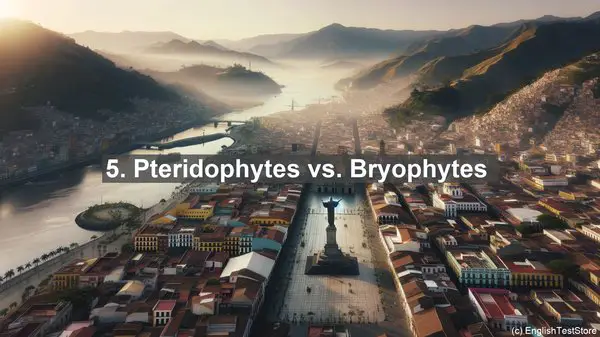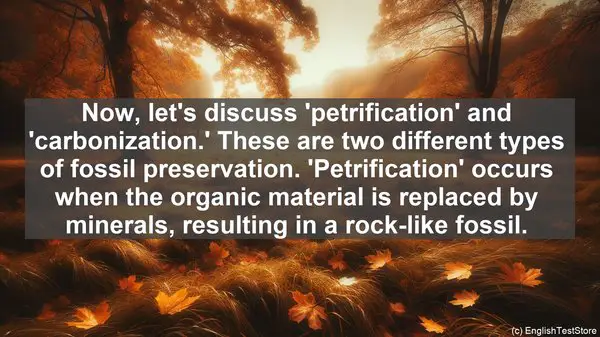Introduction
Welcome to today’s lesson on paleobotany. As you delve deeper into this fascinating field, you’ll encounter numerous terms that may seem similar but have distinct meanings. In this lesson, we’ll explore the top 10 commonly confused words in paleobotany, helping you avoid any confusion and enhancing your understanding. Let’s get started!
1. Fossil vs. Fossilization
The first pair of words that often cause confusion is ‘fossil’ and ‘fossilization.’ While ‘fossil’ refers to the remains or traces of a prehistoric organism, ‘fossilization’ is the process by which organic material is transformed into a fossil. Remember, ‘fossil’ is the end result, while ‘fossilization’ is the process leading up to it.
2. Paleobotany vs. Paleontology
Next, we have ‘paleobotany’ and ‘paleontology.’ While both terms deal with the study of ancient life, ‘paleobotany’ specifically focuses on the study of ancient plants, while ‘paleontology’ encompasses the study of all ancient life forms. So, if you’re interested in plants, ‘paleobotany’ is the term to remember.
3. Angiosperms vs. Gymnosperms
Moving on, we have ‘angiosperms’ and ‘gymnosperms.’ These terms refer to two major groups of plants. ‘Angiosperms’ are flowering plants that produce seeds enclosed in fruits, while ‘gymnosperms’ are non-flowering plants that produce seeds in cones. Remember, ‘angio’ means ‘enclosed,’ while ‘gymno’ means ‘naked.’
4. Petrification vs. Carbonization
Now, let’s discuss ‘petrification’ and ‘carbonization.’ These are two different types of fossil preservation. ‘Petrification’ occurs when the organic material is replaced by minerals, resulting in a rock-like fossil. On the other hand, ‘carbonization’ happens when the organic material leaves behind a carbon residue. So, ‘petrification’ is the mineral replacement, while ‘carbonization’ is the carbon residue.
5. Pteridophytes vs. Bryophytes
Next, we have ‘pteridophytes’ and ‘bryophytes.’ Both are groups of non-flowering plants, but they have distinct characteristics. ‘Pteridophytes’ include ferns and horsetails, which reproduce through spores. On the other hand, ‘bryophytes’ include mosses and liverworts, which reproduce through spores and have a unique water-conducting tissue called ‘phloem.’
6. Stamen vs. Pistil
Now, let’s focus on the reproductive structures of flowers. ‘Stamen’ and ‘pistil’ are the two main parts. ‘Stamen’ refers to the male reproductive organ, which consists of the anther and filament. ‘Pistil,’ on the other hand, is the female reproductive organ, which consists of the stigma, style, and ovary. So, ‘stamen’ is male, while ‘pistil’ is female.
7. Deciduous vs. Evergreen
Moving on to trees, we have ‘deciduous’ and ‘evergreen.’ These terms describe the foliage of trees. ‘Deciduous’ trees shed their leaves annually, usually during the fall, while ‘evergreen’ trees retain their leaves throughout the year. So, ‘deciduous’ trees have a seasonal leaf cycle, while ‘evergreen’ trees are always green.

8. Xylem vs. Phloem
Now, let’s delve into the vascular tissues of plants. ‘Xylem’ and ‘phloem’ are the two main types. ‘Xylem’ is responsible for transporting water and minerals from the roots to the rest of the plant, while ‘phloem’ transports sugars and other organic compounds. Remember, ‘xylem’ is for water, while ‘phloem’ is for food.

9. Pollination vs. Fertilization
Next, we have ‘pollination’ and ‘fertilization.’ These are two crucial processes in plant reproduction. ‘Pollination’ occurs when pollen is transferred from the male reproductive organ to the female reproductive organ. ‘Fertilization,’ on the other hand, happens when the sperm from the pollen combines with the egg, resulting in seed formation. So, ‘pollination’ is the transfer, while ‘fertilization’ is the fusion.
10. Dicot vs. Monocot
Lastly, we have ‘dicot’ and ‘monocot.’ These terms refer to two major groups of flowering plants. ‘Dicots’ have two cotyledons or seed leaves, while ‘monocots’ have one. Additionally, ‘dicots’ have net-like leaf veins, while ‘monocots’ have parallel veins. So, ‘dicots’ have two seed leaves, while ‘monocots’ have one and their leaf veins are parallel.
